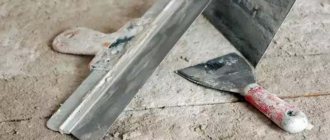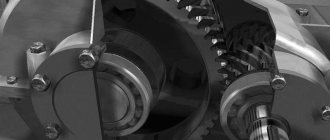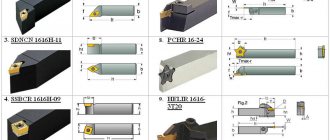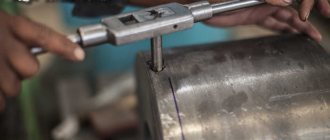Reamer design
There are a variety of different versions of this cutting tool on sale, all of them are characterized by their specific performance qualities. Making reamers is a rather complex process, since all structural parts must be highly accurate. The design of the reamer allows processing of cylindrical and conical holes. Almost all types of cutting tools have an almost similar design:
- The working part, which is responsible for removing metal. It is represented by a combination of several cutting edges. It is worth considering that sharpening of reamers should be carried out taking into account all the features of the geometry.
- The transition neck is also an important part of the geometry. It is designed to distribute the resulting load.
- The shank is intended for fixing the cutting tool in the driver or chuck. The features of this element determine the reliability of fastening and the scope of application of the product. For example, versions intended for manual use have a special shank suitable for fixation in the driver.
Manual Reamer Design
When looking at the development drawings, they pay most attention to the features of the working part. It consists of several parts:
- The main cutting edge, which removes metal. It can have different shapes; metal with increased precision is used in its manufacture.
- Ribbons designed to remove chips from the cutting site.
- Anterior and posterior surface, occipital. They determine the geometric features of the working part.
The marking determines the main parameters of the tool. In addition to the above elements, I will also highlight the following:
- Rear cone.
- The intake part, which is called the cutting part.
- The part responsible for calibrating the instrument before use.
Drill design
Between all the teeth there are grooves that characterize the cutting edge. In addition, the grooves ensure the formation and removal of chips. Manual versions have a uniform arrangement of teeth over the entire cylindrical surface, thereby ensuring the required processing quality.
Device and characteristics
There are a significant number of species and types. But there are almost always basic design elements that remain unchanged. Let's look at them in detail:
- Working part. It is divided into several zones, each of which performs its own functions. The main one is considered to be the fence; it contains cutting edges that have high levels of sharpness. Due to their location, they pick up small amounts of metal from the inner surface. The calibrating part already has many teeth connected into one continuous strip. With its help, calibration occurs. And the final part is the back, this is the fastening element that is adjacent to the neck. This will be discussed further below.
- Neck. A kind of jumper. It allows you to connect the upper and lower structures together.
- Tail. This element is needed to fix the tools in the source. For production standards, this is the machine chuck. At home, a gate drill, for example.
This is the general design of the sweep. But let's focus on certain aspects.
Material
Of course, these are always steels with the highest hardness ratings. But a specific choice should always be based on the resource with which you will have to work. Select rods based on the surface density of the object. In principle, in the vast majority of cases, high-strength alloy steel 9ХС is used; it is usually used for any quality tools. And also some parts of the structure are made from high-speed alloys, such as P9.
Dimensions
They are different. Of course, the holes in production can be of completely different sizes. Thus, conical rods are often placed in the length range of 55-170 millimeters with a spread of 7-46 millimeters. And cylindrical analogues have great variability: length from 80 to 360 mm, and diameter 3-50 mm.
Machine tools for deployment are often highly standardized. They have their own size numbering in numbers from 1 to 6, which corresponds to a range from 1 to 120 mm.
Teeth
The number of incisors affects the final quality. But at the same time, each individual cutting equipment often has less hardness and completely. And also with a large number of edges, problems arise with the removal of metal shavings. Accordingly, if you want to know what reaming a hole is, a photo of a cutting tool can give all the information. The many teeth are highly accurate factory tools, and for simple work, 4 solid edges are usually used. In principle, the top bar is considered to have 14 teeth, but there are some models where their number reaches 16 pieces. But this is subject to high requirements for finished hardware up to class 1 accuracy. Of course, such rods are simply not used at home.
Deployment Processing Features
When drilling, there is a possibility that the dimensions will differ significantly from those that needed to be obtained. This is due to the fact that at the time of machining there is high pressure on the workpiece, the material and the cutting part itself can heat up and deform. This is why many people decide to use a reamer to achieve high quality holes.
The features of the processing carried out include the following points:
- You can achieve processing accuracy that will correspond to a quality in the range from 6-9. Such precise holes are required when obtaining critical products.
- The roughness index can be in the range from 0.32 to 1.25 microns.
- Considering the features of devices intended for deployment, we note that there are about 4-14 cutting edges on the surface. Due to this, the quality of processing and dimensional accuracy are significantly improved. It is the large number of cutting edges that determines that no deformation of the tool or workpiece occurs during cutting.
- When processing a hole, the product rotates around its axis, and it is also given a reciprocating motion. This ensures the removal of edges that could reduce the quality of the surface.
In general, we can say that the drill in use does not differ significantly from the product in question. In both cases there is rotation and reciprocating motion. However, in the case of deployment, the processing carried out is finishing and involves a high rotation speed.
Deployment - what mistakes should not be made?
To obtain the cleanest possible surface, as well as to cool the tool during operation, the holes that were made with a drill in the steel product are lubricated with mineral oil. If the working surface is copper, the hole is treated with emulsion, with aluminum - with turpentine, and if it is brass or bronze, the holes are left without lubrication, since they unfold in a dry state.
High quality of the machining process can be achieved if the reamer has quite a lot of edges cutting the metal. It is thanks to this tool that you can remove a small allowance. After all, by removing a small thickness of metal, you can achieve fairly high accuracy.
A common mistake is the wrong choice of tool for reaming: many people choose a countersink instead of a reamer for this purpose. This is a semi-finish tool that is not capable of showing greater accuracy, it has fewer cutting sharpenings, and in general it is intended for other purposes. Therefore, you need to be careful when choosing a tool. And within one type of tool, you should choose the type wisely.
Tool classification
The classification of scans can be carried out according to a large number of different characteristics.
Some types of scans according to GOST
When considering the types of scans, it should be taken into account that the classification is carried out according to GOST:
- The material used in the manufacture of the main part of the product.
- Design features of the cutting edge and tapes, as well as their location relative to each other.
- The type of hole that can be machined.
- Method of fastening in a collar or machine.
- Possibility of adjusting the size of the hole that will be processed.
Manual reaming has its own specific features that allow you to secure the tool in a special wrench. Modern machine reamers have their own design features that must be taken into account when choosing a tool.
Download GOST 7722-77
The most popular options are:
- The sliding reamer has become very widespread, as it can be used to process holes of various diameters. An expanding reamer with a ball allows you to achieve high dimensional accuracy and the required surface roughness.
- Taper shank versions are also widely used due to their high versatility. The teeth can be made in a mounted form.
- A screw reamer may have soldered plates. They are made using hard alloys that can withstand prolonged mechanical stress without overheating.
Sliding reamers
Helical reamer
As previously noted, the tool in question can be used for machining conical holes. The combined reamer can be used to work with the following types of holes:
- Tapered pins.
- Metric cones.
- A thread that is on a conical surface.
- Surfaces made according to the Morse taper standard.
GOST specifies the accuracy class of the sweep. It depends on the geometric parameters and the type of material used in manufacturing.
Step reamers are used to produce higher quality holes. For example, a two-stage reamer can split the stock, increasing surface quality.
According to the method of use, the following product options are distinguished:
- Manual – a design option that is intended for manual processing of parts. As a rule, a wrench is also used with the working part. It is designed to transmit rotation. It is worth considering that the manual version is designed to remove a smaller layer.
- Mechanical - for use with machines or devices that are powered by electricity. Thanks to its use, processing can be significantly accelerated.
Types of metal reamers
Carbide reamers for metal are very widespread today. This is due to the fact that the hard alloys used can withstand long-term use without the surface wearing out. As a rule, it is the wear of the cutting edge that causes a decrease in surface quality.
Download GOST 13598-851672-80
According to the type of hole being machined
The holes being machined can have very different surface geometries. More widespread:
- Cylindrical holes. They are characterized by the fact that two surfaces are parallel to each other.
- Conical holes. In this case, the formed cavity may narrow. In this case, the angle of inclination may differ significantly.
A conical reamer is selected for each workpiece. This is because the tip must conform to the shape of the cone. The conical surface is quite difficult to process, and only by using the appropriate product can the required shape and quality be achieved.
A cylindrical reamer has a simpler shape; a similar tool is found quite often.
Kinds
WE went through the main species diversity, which divides all instruments into only three groups. But in reality there are much more types. Let's try to take all of them into account.
One-piece
They are often made from tool steel. But there are options made from high-speed metal. These are the simplest, but at the same time reliable equipment. They have become widespread due to their low price niche. You can buy them for 25-50 rubles.
Mounted
These are more expensive and complex specimens. They are produced in the form of an oblong hollow rod equipped with cutting edges on the sides. Their length and quantitative factor are situational; there are different models. The cavity inside is designed for mounting on the tail section. And with the help of the backdrop, the hardware is installed in the machine chuck.
Combined sweep, application
This tool has two working surfaces at once. Accordingly, he can perform finishing processing at different levels, which saves time and resources. At the same time, it is also possible, in principle, to combine two different related procedures. So, with the help of one rod you can immediately carry out countersinking, as well as the final cleaning itself. A convenient choice, but also more expensive compared to conventional analogues.
Unregulated
It is not possible to set the required diameter with this hardware. It is always strictly fixed. This means that the area of operation of one specific sample is significantly narrowed. Suitable in cases where, in principle, there are few quantities in production. And they are all typical. Then it is permissible to choose your own hardware for each type. And if you have to deal with different hole sizes every time, then it is better to use the following device.
Adjustable
By analogy, it becomes clear that this sample is capable of changing diameter. But it’s worth clarifying right away that the range of its capabilities is strictly limited and often quite narrow. But still, within small limits, it can easily replace a dozen of its brothers that do not have the ability to adjust. This is beneficial if there are dozens or hundreds of different types of recesses in production. Then each group will need one of its own hardware. But its cost is often several times higher than that of similar models. On average it reaches 3 thousand rubles.
Awl
This is a special type that belongs to general groups with great reserve. In fact, this is precisely an awl-shaped rod. May have a different number of edges. They are also often found on the market with a removable handle. Not suitable for hard materials. Yes, hardware does a good job with soft plastic, wood, even soft types of metals. It works exclusively in manual mode, which is understandable. After all, it doesn’t even have a mounting part for the cartridge, only a handle that needs to be taken in the hand.
Cylindrical
These are already types of developments based on the shape of the working part. And the first of them is in the shape of a cylinder. It is logical to assume that it is used only if the width of the groove is uniform along the entire length. And this is the most common standard. Such products are mass produced. Depending on the quality and brand, the cost varies from 50 to 100 rubles. And production usually purchases them in huge quantities. And almost every second master keeps a dozen similar products in his own garage.
Conical
Already a rarer type, which is usually not used manually. Designed for holes that taper to one side. The angle is different, which often complicates finishing. And it becomes much more difficult to go through a countersink. It is noteworthy that these hardware products are not at all inferior in price to their common counterpart. And they even win, usually conical products are 30-40% cheaper than cylindrical ones. In principle, this is logical, because their production requires less material.
Stepped
This sample has two or more stages. In fact, the hardware visually resembles its conical counterpart. But the thickening towards the base is not smooth, but as if in steps. The more there are, the higher the quality of processing carried out by the designated species. True, only professional machines work with a large number of steps. In addition, with many transitions, the manufacturer often softens the composition of the steel, making it less hard.
Manual
A large group of products that are united by the fact that they work without a machine. Accordingly, the tail is adapted for a crank and has a square base. But such specimens do not exceed the threshold diameter of 50 millimeters. The restrictions appeared due to the fact that turning thicker hardware would be seriously difficult. After all, the friction force also increases. And if the machine can cope with this without any complications, then in the manual version this technique will not work.
Machine
This is already the type for installation in a cartridge.
And there are a huge number of different varieties. The ranges of standard sizes are varied. But they are often reduced to certain standards, which, for simplicity, are designated by one number. There are also plenty of internal classifications. According to the material of production, the number of cutting edges (there are up to 16 teeth), according to fasteners, the shape of the grooves.
Now, if you are asked, name the types of scans based on processing accuracy, method of use or other parameters - you know exactly what you need to answer.
Manual reamers
Manual reamers
It should be taken into account that manual cylindrical reaming differs significantly from machine reaming. By doing the work manually, high precision can be achieved. When choosing a product, pay attention to the following points:
- Type of cutting part.
- Caliber.
- Number of teeth and uniformity of distribution.
- Groove profile.
- Clamping configuration.
Manual conical reamers are widely used. Hand tools are characterized by their relatively low cost. At the same time, they can be called a universal version. There is a version available with a smooth guide diameter. In addition, the spiral reamer gradually removes the remaining allowance, thereby improving the quality of the surface.
The hand tool has a cylindrical shape. The features include the following points:
- The cutting teeth have sharp edges along their entire length. Due to this, work efficiency can be significantly increased.
- The diameter of the working part can vary from 3 to 58 mm. In this case, the step is about 1 mm. In addition, hand tools are produced in increments of 3.5; 4.5; or other fractional indicators.
- You can also purchase special sets that are presented with a combination of tools of various diameters. Due to this, there are no problems with processing holes of different diameters.
- A distinctive feature is that the shank must fit the collar. This part is designed to transmit rotation and force. For such fastening, the shank must have a square cross-section of the conical part.
- The front surface of the working part of the hand tool has a smaller diameter than the cross-sectional diameter of the main part. This ensures easier entry of the tool into a pre-prepared hole.
- You can increase the quality of the resulting surface by purchasing and using a tool with a large number of cutting edges.
In the manufacture of the main part of the tool, various metals can be used. As a rule, they are characterized by fairly high hardness and wear resistance, but are not designed to work at high cutting speeds.
Manual conical reamer and other types of devices
In order to obtain holes with a clean surface, or if a precise fit of the hole is required for some kind of ground part, a process called reaming is performed. It can be done manually or you can use a drilling machine on which reamers are installed. In the first case, during work, a manual conical reamer is rotated with a crank.
These tools are cylindrical, conical and stepped (according to the type of hole they process). In terms of accuracy, they are divided into the following: those indicating quality (for cylindrical reamers), those indicating quality (roughing, finishing and intermediate between them - for conical types). This also includes cylindrical reamers with a calibrated allowance, which are necessary in order to further grind the tool to the desired size. And the last type in this group is adjustable reamers.
According to the way they are clamped, they are divided into:
- manual (they have a square tail for a knob),
- machine (with a cylindrical or conical shank),
- attachments for machines (installed on a special mandrel, as a rule, needed for large tools).
The working part of this device has cut teeth, usually from 6 to 14, along which there are grooves that form cutting edges.
The part that is located at the bottom of the reamer is designed to remove chips, and the part at the top, called the calibrating part, can launch the tool in the desired direction to completely calibrate the holes. In general, a tool is needed in order to ream tapered holes. The allowance allowed during the roughing stage of work is no more than a fifth of one millimeter, and for the finishing stage it is taken equal to a tenth of a millimeter.
Machine reamers
The emergence of various machines can significantly increase labor productivity. A drilling machine with a low spindle speed allows you to produce high-quality holes in less time. GOST also defines the classification of tools according to a fairly large number of different characteristics. The cylindrical machine reamer is characterized by the following features:
- The tool has a large number of cutting edges. It is worth considering that as this indicator increases, the quality of the surface significantly improves.
- In the manufacture of the cutting part, carbide metals are used that can withstand high temperatures.
- The cutting part can be quite long.
Conical reamers
There is also a machine conical reamer, which is designed for use on machine tools. Machine deployment is performed when high performance is required. It is worth considering that due to the large number of cutting edges, it is important to accurately regulate the rotation speed.
In the manufacture of tools, special high-speed steel is used, which can withstand prolonged mechanical stress and temperature changes. Due to the special shank, the tool can be mounted in various equipment for machine tools.
Application of sweeps
It is almost impossible to achieve high precision and surface quality when using a conventional drill. This is due to the peculiarities of the working part, which has a relatively small number of cutting edges. The use of the products in question can significantly improve the quality of the hole and bring all indicators to the required levels. The scope of application of the tool is extensive:
- Mechanical engineering industry.
- Production of precision products.
- Manufacturing of household appliances and various electronics.
- Machine tool industry.
Note that the wrench used is suitable for various hand tools. In addition, the machine-type product is suitable for almost all cartridges and can be used when performing intermediate operations.
In conclusion, we note that preference should be given exclusively to products from well-known manufacturers. This can be attributed to the fact that they guarantee high quality production and a long service life of the product. However, due to quality control at each stage of production and the use of high-quality materials, the cost of the product increases significantly.











